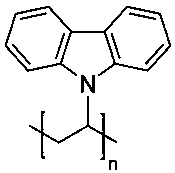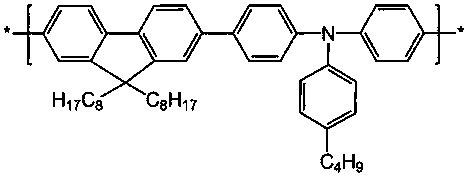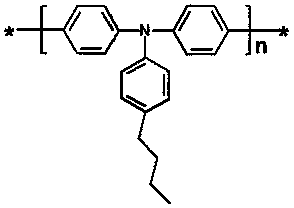Film, preparation method thereof and QLED device
A thin film and device technology, applied in the field of quantum dots, can solve the problems of concentration quenching, insufficient energy level and exciton binding ability of quantum dots, and low luminous efficiency of QLED devices, so as to reduce interaction and suppress non-radiative energy transfer and effect of concentration quenching, high-efficiency QLED devices
- Summary
- Abstract
- Description
- Claims
- Application Information
AI Technical Summary
Problems solved by technology
Method used
Image
Examples
Embodiment 1
[0103] The preparation method of the thin film of different quantum dot weight percentages in this embodiment comprises the following steps:
[0104] 1) Weigh 20 mg of CdTe / CdZnS core-shell quantum dots and fully dissolve them in 10 mL of chlorobenzene to form a quantum dot solution with a concentration of 2 mg / mL. The luminescence peak of this quantum dot solution is 631 nm, with a half-peak width is 30 nm, and the luminous quantum yield is 56%;
[0105] 2) Weigh 40 mg, 30 mg, 20 mg, 10 mg, 8 mg, 4 mg, 2 mg, 1 mg, 0.5 mg, 0.3 mg, 0.1 mg of PVK respectively (weight average molecular weight: ~1.1 million) Each was fully dissolved in 0.5 mL of chlorobenzene;
[0106] 3) Add 0.5 mL of the quantum dot solution prepared in step 1) to the above-mentioned PVK chlorobenzene solution and mix thoroughly to form PVK / QD weight concentrations of 40 / 1, 30 / 1, 20 / 1, 10 / 1, 8 / 1, 4 / 1, 2 / 1, 1 / 1, 0.5 / 1, 0.3 / 1, 0.1 / 1 mg / mL chlorobenzene solution;
[0107] 4) In an inert atmosphere, the above-men...
Embodiment 2
[0109] The effect of adding barrier polymer materials on the quantum yield of thin film luminescence
[0110] The luminescence quantum yields of each film in Example 1 are shown in Table 1 below. Compared with the film formed by pure quantum dot material (the last row), different proportions of barrier polymer materials (in this example, PVK) can significantly improve the luminescence quantum yield of the film, from 3% of the pure film to 53%, which is basically close to the luminescence quantum yield of quantum dots in the solution, indicating the isolation effect of PVK polymers on quantum dots in the film good. In this example, PVK has a large weight-average molecular weight (1.1 million). It can be seen that the weight percentage of QD can improve the luminous efficiency in a wide range of 2-90%.
[0111] Table 1. Luminescence quantum yield of thin films
[0112]
Embodiment 3
[0114] The preparation method of the thin film of different quantum dot weight percentages in this embodiment comprises the following steps:
[0115] 1) Weigh 20 mg of CdTe / CdZnS core-shell quantum dots and fully dissolve them in 10 mL of chlorobenzene to form a quantum dot solution with a concentration of 2 mg / mL. The luminescence peak of this quantum dot solution is 631 nm, with a half-peak width is 30 nm, and the luminous quantum yield is 56%;
[0116] 2) Weigh 40 mg, 30 mg, 20 mg, 10 mg, 8 mg, 4 mg, 2 mg, 1 mg, 0.5 mg, 0.3 mg, 0.1 mg of PVK (weight average molecular weight: ~500,000) Each was fully dissolved in 0.5 mL of chlorobenzene;
[0117] 3) Add 0.5 mL of the quantum dot solution prepared in step 1) to the above-mentioned PVK chlorobenzene solution and mix thoroughly to form PVK / QD weight concentrations of 40 / 1, 30 / 1, 20 / 1, 10 / 1, 8 / 1, 4 / 1, 2 / 1, 1 / 1, 0.5 / 1, 0.3 / 1, 0.1 / 1 mg / mL chlorobenzene solution;
[0118] 4) In an inert atmosphere, the above-mentioned chlorobenz...
PUM
| Property | Measurement | Unit |
|---|---|---|
| Luminescence peak | aaaaa | aaaaa |
| Half width | aaaaa | aaaaa |
| Half width | aaaaa | aaaaa |
Abstract
Description
Claims
Application Information
 Login to View More
Login to View More - R&D Engineer
- R&D Manager
- IP Professional
- Industry Leading Data Capabilities
- Powerful AI technology
- Patent DNA Extraction
Browse by: Latest US Patents, China's latest patents, Technical Efficacy Thesaurus, Application Domain, Technology Topic, Popular Technical Reports.
© 2024 PatSnap. All rights reserved.Legal|Privacy policy|Modern Slavery Act Transparency Statement|Sitemap|About US| Contact US: help@patsnap.com










